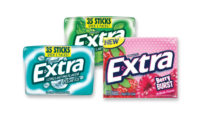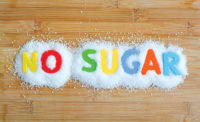To some candy lovers, a sugar-free label can cause a grimace.
After all, candy is supposed to be sweet, right? Yet to a growing number of consumers, sugar-free candy is the opposite of an oxymoron; it’s a guilt-free way to indulge while still being able to appease their taste buds.
Sugar-free is popping up in more products and flavors, with a specific call to those with health concerns. Yet rebranding sugar-free products as tasty and good on all fronts is important right now to attract consumers who have been more likely to reach for other products they perceive to taste better, or those who eschew candy altogether.
For example, Eda’s Sugarfree Candies, as its name implies, is all about the sugar-free category and has been since it started in 1958.
Rather than having separate sugar and sugar-free lines, the company dedicates all its efforts to producing candy without sugar. It uses sorbitol, a sugar substitute found naturally in a number of fruits, to sweeten its treats.
Eda’s products keep health concerns, especially those of diabetics, in mind.
According to the American Diabetes Association, 29.1 million Americans (9.3 percent of the population) have diabetes as of 2012. An additional 86 million Americans in 2012 had prediabetes, in which they exhibit some criteria of diabetes and have blood sugar between normal and diabetic levels. It remains the seventh-leading cause of death, and its prevalence is growing — the number of Americans with diabetes in 2012 grew by 3.3 million people from 2010.
With the expanding market that diabetics provide — especially among the older generation, 26 percent of whom have the condition — candy makers have reason to cater to them. Those with diabetes must watch their sugar intake, despite any cravings for sweets they might have.
That’s where sorbitol comes in. Sorbitol, a sugar alcohol, has fewer calories than sugar and can be metabolized easily without severely changing blood sugar levels. Eda’s claims to be the only sugar-free hard candy on the market to use that sweetener in its products.
Customers who find a brand of candy that works well for them and tastes good will stay loyal, says Mike Bernert, Eda’s v.p. of sales and marketing. The company has received positive feedback from both diabetics and nondiabetics.
A main concern for consumers with sugar-free candy is the taste; a number of sweeteners have an aftertaste that turns them off.
“Consumers generally perceive, before they try a product, that it’s going to have an aftertaste,” Bernert explains. He tries to combat this with Eda’s trusted recipe of more than 50 years and sampling groups that provide feedback.
In the end, the products win. There is no recognizable aftertaste, and consumers still get a sweet treat without sacrificing their health.
Bernert adds that there is additional wariness among consumers toward sugar-free products due to the prevalence of sugar-free products that use artificial sweeteners. Packaging and branding can help products in this regard. Eda’s unveiled new premium packaging in the fall that tries to educate consumers on what exactly is in the product that makes it a good choice.
The use of sorbitol can turn manufacturers away due to the laxative effect the sweetener has if consumed in excess. However, Bernert argues this negative (which is made known to consumers on Eda’s packaging) has not had much of an effect. Though he admits there might be some initial caution upon seeing the warning, the laxative effect is not as detrimental as an aftertaste would be, especially because consumers tend not to eat more than a few pieces of the candy at a time.
The new packaging also stresses the natural ingredients more than it used to, though Bernert asserts that sugar-free candy is more desired for its health benefits than its natural ingredients.
“Health still drives sugar-free,” he says, adding that candy is an indulgence, and consumers look for something similar they can have in place of treats loaded with sugar.
Trends in the sugar-free category revolve around these diet and nutrition issues more so than innovations in product type or flavor, though there is some migration toward sour flavors, according to Bernert. Eda’s has released a sour mix of its candies to ensure it doesn’t get left out.
Sour favorite Sour Patch Kids is also throwing its hat in the ring. The brand partnered with popular gum brand Stride to create a Sour Patch Kids gum, which is sugar-free. Like Eda’s, the gum uses sorbitol as its sweetener.
Sour Patch Kidsbenefits by choosing gum as its entrance into the world of sugar-free candy. As Deborah Schimberg, ceo of Verve Inc., which produces natural gum brand Glee Gum, explains, gum is a unique category in which the sugar-free option is not a niche or an afterthought to companies.
“Sugar-free gum is fundamentally a little bit different than sugar-free candy in that a lot of sugar-free candy has been directed at the older diabetic market,” she says. With gum, dental health is the first concern, a concern everyone can relate to. As such, all major gum brands do sugar-free to be “the norm, rather than the exception.”
Schimberg agrees with Bernert that the sugar-free label is a bigger draw than the natural label, but using natural sweeteners in sugar-free products is still important.
“Consumers for a long time have been looking for natural sweeteners that taste good,” she says.
Unlike Eda’s, Glee Gum offers a line of products made with real sugar alongside its sugar-free line. Both are about equally as popular, but the sugar-free products are growing at a faster rate than those with sugar.
Natural ingredients are the common denominator between the two lines. Everything is all-natural, which Schimberg believes is a bigger issue in the sugar-free gum category due to the frequent use of aspartame — an artificial sweetener that has seen controversy over whether it is harmful to health.
“Consumers that are looking especially for natural products, it’s tricky. They don’t trust aspartame,” Schimberg says. Additionally, they “assume artificial sweeteners are bad, period.”
Glee Gumhas experimented with a number of natural sweeteners in its products, but sticks with xylitol, a sugar alcohol derived from birch and beech trees that is a popular natural sweetener for gum. Stevia was ruled out for its aftertaste, and other sugar alcohols were nixed for causing digestive problems, such as the laxative effects that sorbitol can cause.
Sales of natural gum have been going up, Schimberg says, and Glee Gum is working to stay at the forefront of this trend. It is the only gum on the market with certified non-GMO ingredients, which many consumers look for.
“The fact that we’ve gone the extra mile in being certified … it shows the consumer we’re credible,” Schimberg says.
The brand also advertises its commitment to the environment. It is the only gum on the market to use chicle, a natural and sustainable sap, as its gum base. Schimberg believes this additional unique quality allows the brand to appeal to both the health-conscious and the environmentally-conscious consumers.
“Consumers are always looking to have it all,” she says. “What we’re offering to consumers is the opportunity to have it all.”







